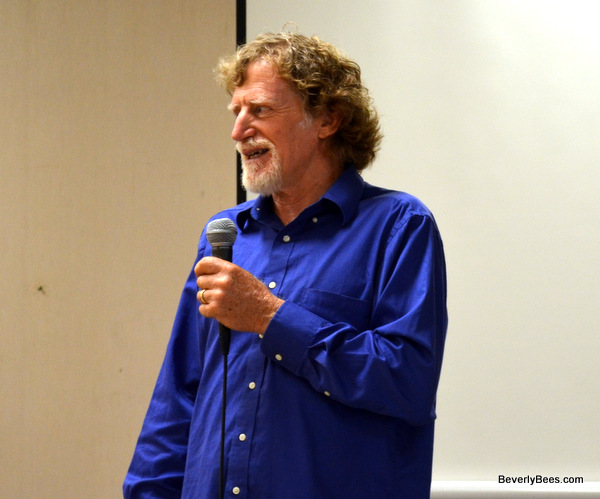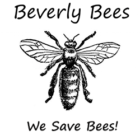Top Bar Hives With Les Crowder
At the Treatment Free Beekeeping Conference, Les Crowder gave a talk on top bar hives. Les has been keeping bees for over 30 years. He used to work in commercial beekeeping using Langstroth hives before switching to the top bars he uses now. He has also used top bars for pollination. Les spent five years as the New Mexico Honeybee Inspector and as the President of the New Mexico Beekeepers Association. He is a natural treatment free beekeeper and has been teaching beekeeping classes since 1983. He has been such a great advocate for top bars that most backyard beekeepers in his club are now keeping bees using top bars instead of Langstroths. He has recently published a book called Top-Bar Beekeeping: Organic Practices for Honeybee Health. He also has a website about top bar beekeeping called For The Love Of Bees.
Les talked about the benefits of top bar hives at the conference and here are a few things he mentioned. Some bees are more resistant to disease but that does not mean you can keep old comb in the broodnest. Old combs increase brood disease. In nature, wax moths are symbionts, they clean up the old comb and bees let them do it. Keep bees in a way that honors the web of life. Let bees decide the cell size they need. If you use no treatments you have clean honey for the table and the farmer’s markets.

Order bees and line up a good queen. You can use virgin queens but you need a good local queen. It is harder to kill bees using top bars. When you put the bars in you can bump bees gently and wiggle the bars to move the bees out of the way. When harvesting honey you can crush the comb, pour the slurry into a strainer and the honey will drip through while the wax stays put. Then you can take the wax out and melt it in a solar wax melter. With top bars you can easily extract one batch of one type of honey. It is easy to process smaller batches than is possible with Langstroths. The honey can be harvested faster and this is a benefit for fast crystallizing honey. The honey will stay uncrystallized longer in the jar because it is harvested faster.
Top bars give about 80% of the honey that a Langstroth does. But they are cheaper to make, easier to handle, have less maintenance and a quicker honey crop. A study should be done on dollar per dollar per system using a honey yield over 2-3 years.
If you are interested in building a top bar hive, email Les through his website at fortheloveofbees@kitcarson.net and he will send you a PDF version of top bar plans. His hives are 42″ long and he uses a 1×10 with a solid bottom and thirty 20″ top bars (19.5″ top bars will fit a Langstroth) and a 9 1/4″ bottom. Another thing he mentioned was that the angle is important. At 120 degrees the bees will stop attaching comb to the sides and this angle also maximizes the box volume. He also prefers a side entrance to an end entrance. For a cover he uses a piece of flat Masonite measuring 42′ x 20″ although a telescoping cover is nice for moving bees. If you turn a Langstroth hive sideways, that is essentially a top bar hive.
If you don’t want to spend money on a hive you can use scrap lumber to make a top bar hive. You barely need a hive tool in a top bar hive. You can dump a package into a top bar hive. The bars should have cleats unless you have a few combs already then you can put a flat bar between two combs and they will draw comb on it. If the comb is at a wrong angle pull it off or push it straight and put it between 2 straight combs. If you have too many empty spaces between the brood it is harder for them to keep warm in the spring so you need to be careful.
Top bar hives cost about 1/2 as much and give a little less honey but they make a lot more wax. If you are a treatment free foundationless beekeeper your wax without miticides is very valuable and can be sold at a premium. Top bars make the same amount of wax as they do honey.
Top bars need to be managed every 2-3 weeks. To get the bees to draw comb correctly you need comb guides. Bars with drawn comb work best. Space them right and use the right management techniques to get them to draw them correctly.

Frank Eishcen talked about plants to use as miticides. While Les does not do this anymore, he has previously used juniper bark and creosote bush smokes and found them to be very effective. People can also do the same with sumac head smoke by puffing 40 puffs of smoke into the hive at one time, once a year. Les does not care about mites anymore. We need to work with nature’s resistance, if we fight it, we will lose. If we don’t, we will win. Les uses Russian bees in his hives.
When the bees start building wax they make teardrop shapes and draw down. They can build whatever size cell they want. They can build any space or shape they want. Bees make you get in touch with the flora. You can stretch the hive by putting in empty bars. Put honey in the doorway and empty combs in the broodnest. Combs are ready to harvest as soon as honey is capped. In fall, collapse the broodnest, letting them collapse and condense.
With top bars you can make a mixed origin divide into another empty box with comb/honey, honey/pollen, brood, brood, brood. Bees use less honey in a top bar than they do in a Langstroth. You can take treatment free, safe honey and put it in the bottom of the hive for the bees. You can also use a jar with sticks under it or a boardman feeder if you need to feed them.
Les is always looking to the trees for swarms. He also recommends having a jug of water in your car for sticky hands after inspecting hives. Bees are the real teachers. 1000 beekeepers with 100 hives could be critical to the future of beekeeping to replace the aging commercial beekeeping industry. We are the salvation, the solution is the flowers and bees.
Don’t miss out! Stay informed of the latest beekeeping news and events, get yummy honey recipes, instructional posts and more. For beekeeping stories and tips, sign up now to receive our free monthly email newsletter and/or get weekly blog posts by email.
Sign up here for our free email newsletter!
